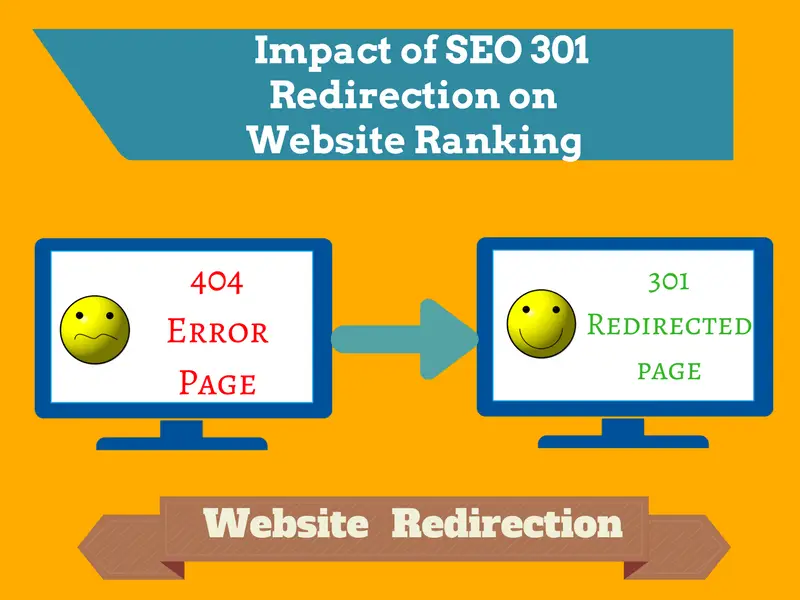Impact of SEO 301 Redirection on Website Ranking

Welcome to our blog today, we will be exploring the significant impact of SEO 301 redirection, how by redirect old or outdated URLs to new ones? and how SEO 301 redirection helps retain valuable link equity and ensures a seamless user experience? can this powerful technique play a crucial role in website optimization and search engine rankings?
In the web, the process of forwarding one URL to another URL is known as redirection, Redirect is a way to send both users and search engines to another URL of a website other than the original request. There are three types of redirects i.e. 301, 302, and meta refresh. However, the behavior of page redirects can be vital for SEO and webmasters as it can help to get page ranking and link juice to a website.
Discover the power of SEO 301 redirection as we explore its advantages, best practices, and helpful hints; Let's make the most of this revolutionary approach together!
Impact of SEO 301 Redirection on Website Ranking
What is 301 Redirect?
A 301 Redirect is a permanent redirection from one URL to another URL of a website where a visitor is redirected to a new page rather than the original page they typed for or got on the search results page.
The 301 redirects tell the search engines that this page is moved permanently and all the qualities are assigned to the new page. By using redirects, website owners can direct visitors to the most relevant and updated content, even when URLs change, this functionality helps maintain search engine rankings, retain link equity, and prevent broken links.
Reasons for 301 Redirecting a page
A 301 redirect is a permanent redirect that produces 90-99% of link juice (page rank) to the redirected page. It redirects both the users and search engines to the new URL or the changed page location. The 301 indicates the browsers and search engine bots that the page has moved permanently. But the purpose of redirecting a page may vary within the people i.e.
- Broken URL or not working
- Inactive webpages
- Website Restructuring
- Designing a new webpage or site for the visitors
- Modifying the webpage or site migration
- Maximize domain authority
- Handling duplicate content
- Consolidating Multiple pages
The main reason for 301 permanent redirects is for better search engine optimization (SEO), it increases the link juice or inbound links that help to get high search rankings and site traffic. Whether it's a website restructuring, URL change, or rebranding, redirecting web traffic plays a crucial role in preserving SEO efforts and ensuring that users can easily find the information they are looking for.
Differentiating Between 301, 302, and Other Redirects
First understand the differences between various redirect types, such as 301, 302, and others.
A 301 redirect is a permanent redirect that informs search engines that a URL has permanently moved to a new location, It passes the link equity and ranking power from the old URL to the new one.
On the other hand, a 302 redirect is a temporary redirect that indicates a temporary move, unlike a 301 redirect, a 302 redirect doesn't transfer the link equity or ranking power.
There are also other types of redirects, such as 307 redirects for temporary moves and meta refresh redirects that automatically refresh the page after a specified time.
Choosing the right redirect type depends on the specific situation and the desired outcome, permanent moves should use a 301 redirect, while temporary changes may require a 302 or 307 redirect.
Implementing 301 Redirects on Server Files
301 redirects can be deployed only if you make a change on your website to permanent, It can be done in 3 ways is:
1) Using the .htaccess file, an Apache technology on your root directory and should be transferred to ASCII code, the redirects are typically managed through the .htaccess file & located in the root directory of your website.
```
# Permanent URL redirect .htaccess code
Redirect 301 /old-page.html https://www.example.com/new-page.html
```
2) Using IIS on Microsoft Windows Server to redirect websites which is found on the start menu under administrative tools. With this you can create websites, configure security settings, manage application pools, monitor server performance, and perform many other tasks related to web hosting and development.
3) Using the temporary redirect code of a webpage in any programming language, Redirect via server-side scripting like access to server-side scripting languages like PHP or Python can handle redirects using code. Here's an example in PHP:
```
php
header("HTTP/1.1 301 Moved Permanently");
header("Location: https://www.example.com/new-page.html");
exit();
?>
```
This code sends a 301 status code and redirects to "http://www.example.com/new-page.html"
Before moving to a permanent URL, you should set up 301 redirects between http:// and http://www domain versions and set up redirects to the old internal links on your website, this helps in any content duplication issues and protects your site from being penalized by Google Algorithm.
Common Mistakes to Avoid while Implementing 301 Redirects
- Not Properly Redirecting All Versions: Ensure all versions of the URL (www and non-www, HTTP, and HTTPS) redirect to the preferred version to prevent duplicate content issues like 301, 302, and 307.
- Using Multiple Redirects: Redirecting through multiple steps (chaining redirects) can slow down the process and affect SEO. Aim for direct, single-step redirects.
- Ignoring Internal Links: Update internal links across your website to point to the new redirected URLs & neglecting internal links can lead to broken links and negatively impact user experience and SEO.
- Failing to Update XML Sitemap: Update your XML sitemap to reflect the changes made with 301 redirects, this helps search engines discover and index the new URLs efficiently.
- Incorrect Redirect Mapping: Ensure the mapping of old URLs to new URLs is accurate. Mismatched redirects can result in users landing on irrelevant or broken pages.
- Not Testing Redirects: Failure to test the redirects after implementation can lead to unnoticed errors. Always test each redirect to verify they are working as intended.
- Missing Mobile and Desktop Redirections: For responsive or separate mobile sites, ensure proper redirection between mobile and desktop versions to maintain user experience and SEO.
- Redirecting Everything to the Homepage: Redirecting all old URLs to the homepage instead of relevant new pages can harm user experience and SEO authority.
- Removing Old Content Prematurely: Avoid deleting old content immediately after redirection. Allow search engines time to recognize and index the new URLs before removing old content.
- Not Monitoring Performance: Failure to monitor and track the performance of redirects can lead to missed issues and lost traffic. Regularly check for errors and unexpected changes in traffic.
Avoiding these mistakes while implementing 301 redirects can help maintain SEO traffic, user experience, and prevent redirection issues that may arise during the redirection process.
Case Studies and Examples of 301 Redirect Implementation:
Real-Life Scenarios of 301 Redirect Implementation
1. Website Domain Migration
- Moving from http to https for security reasons.
- Merging two websites into one (e.g., acquiring a competitor).
- Changing domain names for branding or marketing purposes.
2. URL Structure Changes
- Updating outdated URL formats for cleaner, more SEO-friendly ones.
- Consolidating product pages with different variations into a single page.
- Moving content to a new subdirectory or section of the website.
3. Page Consolidation
- Combining similar or duplicate content into a single, authoritative page.
- Removing outdated or low-quality pages that hurt website performance.
- Fixing broken links and redirecting users to relevant existing pages.
4. Content Removal
- Removing products or services no longer offered.
- Taking down pages no longer relevant to the website's focus.
- Redirecting obsolete articles to updated versions on the same topic.
5. Temporary Redirects
- Sending users to a maintenance page during website updates.
- Directing traffic to a holiday landing page during a seasonal promotion.
- Redirecting users to a different page for A/B testing website features.
Success Stories and Examples of Websites Using 301 Redirects
1. Etsy
- In 2017, Etsy migrated from using separate URLs for different countries (e.g., etsy.com, etsy.co.uk) to a single global domain (etsy.com) with language and currency options.
- They used 301 redirects to seamlessly guide users to the correct pages on the new domain, maintaining search rankings and user experience across international markets.
2. CNN
- CNN regularly updates its website's structure and content, often resulting in URL changes.
- They consistently use 301 redirects to ensure that old links still lead to the appropriate content, preserving link equity and avoiding broken links.
3. LinkedIn
- When LinkedIn acquired Lynda.com, they merged the two websites into a single platform.
- They utilized 301 redirects to redirect users and search engines from Lynda.com's URLs to the corresponding pages on LinkedIn Learning, ensuring a smooth transition and preserving the value of Lynda.com's content.
4. Moz
- Moz, a leading SEO software company, redesigned its website with a new URL structure.
- They implemented a comprehensive 301 redirect plan to map old URLs to the new structure, effectively maintaining rankings and avoiding traffic loss.
5. The New York Times
- The New York Times regularly updates its articles and archives, sometimes changing URLs in the process of 301 redirects to ensure that readers and search engines can always find the most current version of an article, even if the URL has changed.
However, when it is used 301 redirects properly it can be a powerful tool for maintaining SEO performance, improving user experience, and optimizing website performance.
SEO Tools for Managing and Implementing 301 Redirects
Here are some common SEO tools that can help you manage and implement 301 redirects:
1. Redirection plugins for content management systems (CMS)
- WordPress: In WordPress, several plugins can assist with managing redirects like Redirection, Yoast SEO Premium, Rank Math, and All in One SEO Pack are popular choices. These plugins offer features are redirect creation, monitoring, and management, ensuring a smooth user experience and helping with SEO optimization.
- Drupal: The Redirection 404 and Pathauto modules are the go-to options. Redirection 404 allows for the creation and management of redirects, while Pathauto automatically generates search engine-friendly URLs, minimizing the need for redirects.
- Joomla: In Joomla, the Redirect Manager feature provides a simple and efficient way to manage redirects; With this tool, users can easily create and manage redirects, ensuring smooth navigation of Joomla websites.
- Wix, Squarespace, and Shopify also provide a redirects manager. This feature allows you to create and manage redirects within their respective platforms. With the redirects manager, you can easily redirect visitors from one URL to another, ensuring a smooth user experience and preventing broken links.
2. SEO Software
- Ahrefs: The Site Audit feature of Ahrefs is great for marketers and website owners, can detect redirect issues and fix them so your website runs smoothly.
- SEMrush: SEMrush is a powerful tool that every website owner should have in their arsenal, with its Site Audit feature, you can easily identify any redirect issues that may be affecting your website's performance.
- Screaming Frog SEO Spider: If you're having trouble figuring out why your site isn't performing as it should, the Screaming Frog SEO Spider can help you out, it crawls your site finds redirect chains, and loops fast.
3. Online redirect checkers:
- HTTP Status Code Checker: Website owners and SEO specialists can utilize the HTTP Status Code Checker tool to ensure that redirects are functioning correctly and providing users with a positive experience. It will be easy to verify redirect status codes, chains for specific URLs, and problems with redirects.
- Redirect Detective: To better understand how a URL is being redirected, Redirect Detective may reveal its whole redirect path. With Redirect Detective, you can easily determine the type of redirects used, such as 301 or 302, and identify any potential issues or misconfigurations.
4. Browser developer tools:
- Chrome DevTools: Chrome DevTools allows you to examine page-by-page redirection. Through the use of this tool can may examine the redirect chain, verify the status codes, and detect problems that might impact the website's functionality.
- Firefox Developer Tools: This tool allows you to examine redirects, see the redirect chain, and examine status codes which basically gives you a good idea of how the redirection works.
Advantages of SEO 301 Redirect
301 redirect benefits to both site navigation purposes for better user experience and SEO for the preservation of link juice. But there are some other advantages are:
1) Traffic value - While moving your website to a new domain or URL all the traffic will be redirected from the old domain to the new one. It can also help consolidate traffic and authority onto relevant pages, potentially boosting their ranking for targeted keywords.
2) Boosts Page Rank - It helps your website rankings to smoothly flow from an old URL to a new permanent URL without any hassle. It drives organic traffic to your new web pages or site.
i) Attract links
ii) Reducing crawl errors
iii) Fixing duplicate content,
iv) Optimizing the website speed
v) Targeting relevant keywords
3) SEO - SEO relies on server-side 301 redirects to indicate to search engine bots and servers that a new URL has replaced the old one. This ensures that existing rankings, traffic, and backlinks associated with the old URL transfer to the new URL preserving the website's authority and maintaining SEO performance.
4) Fix Duplicate Content Issues - There may be a possibility of duplicate content issues from the old domain to the original domain name. But 301 redirects indicate Google bots to crawl and index the updated version which will rank first.
5) Page Authority - Page Authority predicts a webpage's ranking on the SERP, by increasing the page authority of new URLs, improving their chances of higher rankings. This metric considers factors like backlinks and content quality to determine a page's relevance and authority.
6) Link juice - When implementing a 301 permanent redirect, it transfers a significant amount of link juice, which represents the ranking power of a webpage or site, to the new URL. Generally, between 90-99% of the link juice is passed on, ensuring that the new URL retains the ranking potential of the original page or site.
Disadvantages of 301 Redirects
Most SEO and Webmasters think that 301 is the best solution to redirect their websites permanently, but it has several drawbacks also.
1) Unnatural Backlinks - When you perform 301 redirect a domain permanently the bad links or unnatural links go with it. These bad links will point to your new domain or URL and may cause your website low rankings or even a penalty from Google.
2) Cloaking - Cloaking happens when you show different content or URLs to the users and search engine bots. It occurs while redirecting to a new domain the text, links, and HTML are shown to search engines whereas only flash or images are to the users. This may penalize your website as it violates the Google webmaster guidelines.
3) Doorway pages - Doorway pages are low-quality pages in which each page is optimized for a particular keyword or phrase. The doorway pages are created if 301 redirect happens multiple times i.e. 10-15 times. Google detects these doorway pages and warns you, and also can penalize your website.
4) Affects Page Speed - 301 redirects cause your web pages to load slower and affect user experience, it can also lead to your website being removed from the search engine results page.
5) Duplicate Content - Duplicate content appears on more than one page for URL variations that happen due to 301 redirects. It can be URL parameters like click tracking or analytics code which is the main reason for duplicate content issues.
6) User Experience Issues - Incorrect redirects may result in broken links or irrelevant content, negatively impacting user experience and engagement.
7) Loss of SEO Equity - Improperly executed redirects can lead to the loss of valuable SEO equity and rankings accrued by the original URLs. Drastic changes in URL structure or content relevance might cause a temporary drop in search engine rankings.
Conclusion
In conclusion, 301 redirections can boost your website's SEO. Redirecting outdated or unnecessary URLs to new, relevant ones preserves link equity and accurate ranking power.
This ensures that your website maintains its visibility and authority in the eyes of search engines; Ultimately utilizing 301 redirections for optimizing your website's ranking potential and improving the SEO performance.





